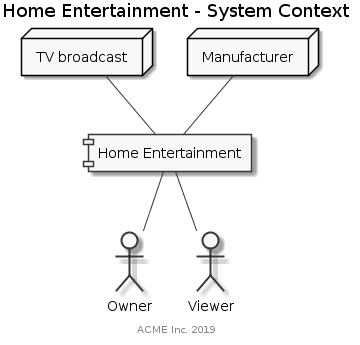System Scope and Context
Business Context

| Actor | Description |
|---|---|
Manufacturer |
The manufacturer of the hardware may update firmware without interaction of the device owner |
Owner |
The owner controls the home entertainment system via various controls |
Viewer |
Audio and visual information from the system is consumed by the Viewer (which may be identical to the Owner) |
TV Broadcast |
TV content is distributed to the system via a broadcasting service over Satellite |
Technical Context

| Interface | Description | I/O |
|---|---|---|
Audio |
The system generates audio information and outputs it via speakers to the Owner |
out:Soundwaves |
Video |
Visual information is tranferred to the Owner |
out:Light |
LAN |
Local area network connection is used for communication between the Owner and the system |
in:media control |
WAN |
An internet connection is used by the system to update its firmware via the Manufacturer or to fetch online content |
out:HTTPS |
Remote Control |
A remote control is used by the Owner to modify the system state |
in:physical interaction |
Satellite |
Using the |
in:DVB-S |